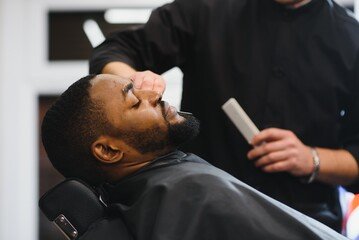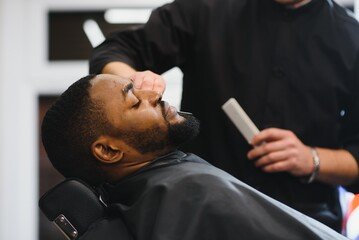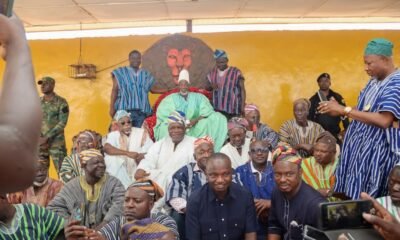Features
Religion and the Ghanaian diaspora in Finland

African Catholic Chaplaincy in Finland
The last time, I wrote about how Ghanaian groups or companies operate in some Finnish cities, especially in the Helsinki Metropolitan area.
As I keep pointing out, there are many positive things that Ghanaian individual migrants or groups (or their companies) are accomplishing or trying to accomplish for their wellbeing in Finland.
Today, I focus on the religious activities of Ghanaian migrants in Finland and the role of religion in their lives as part of the many positive things that are happening within the Ghanaian migrant community.
I have promised to write about such positive things at points in time as highlights of how Ghanaian migrants in Finland are making efforts to enhance their wellbeing in Finnish society.
Religious freedom in Finland
Finland is a Christian country where over 3.7 million people (about 66%) of the population of 5.5 million belong to the Evangelical-Lutheran Church of Finland, according to 2021 estimates. The remaining figures belong to other denominations, including people who do not profess to belong to any religion (see www.wikipedia.org).
Actually, there is religious freedom in Finland and any individual is free to choose the type of religion to belong to or not to belong to.
The constitution of Finland guarantees freedom of religion and freedom of conscience, according to information on the website of the Finnish Ministry of Education and Culture (seehttps://okm.fi/en/freedom-of-religion).
Ghanaian migrants in Finland are free to belong to any religion in Finland or to worship in any church, mosque, synagogue, etc. Thus, the places of worship undoubtedly make up part of the personalities and institutions that have contributed to or ensured the smooth running of things for Ghanaian migrants in Finland.
Christians and Muslims
Many Ghanaian migrants in Finland identify either with Christians or Muslims. Many of the Christian Ghanaian migrants go to church on Sundays.
The Ghanaian Muslim group is a strong, well-knit one, and they visit the mosque on Fridays.
It must be pointed out that there seems to be more Christian Ghanaian migrants in Finland, although this estimation is based on my own rough evaluation and not on any official statistics.
They go to various churches, and some of these churches are even dominated by Ghanaian migrants in Finland.
Churches dominated by Ghanaian migrants
One of the major Pentecostal or Charismatic churches dominated by Ghanaian migrants is the Church of Pentecost (COP) in Finland.
The COP Finland has become one of the major channels through which the Ghana Union Finland (GUF), an association for Ghanaian migrants in Finland, has made more contacts with members of the Ghanaian migrant community.
The church has two branches in Helsinki alone, both dominated by Ghanaian migrants in Finland. There is the Akan Assembly, where worship is done mostly in the Twi language, with the other branch known as the English Assembly (or the PIWC), which is attended by other nationalities and African migrants but is also arguably dominated by Ghanaian migrants.
Other churches frequented by Ghanaians are the Methodist, Temple of Praise (TOP), ICBC, Lighthouse, the Assemblies of God, the Catholic Church, etc. It is likely that other churches, such as the Apostolic Church and Charismatic ones, could also be established soon in Finland.
Ensuring integration
All this indicates the opportunities for members of the Ghanaian diaspora in Finland to integrate into Finnish society through their religious activities and affiliations.
As I keep pointing out, Finland encourages migrants’ participation in the planning of issues concerning the migrants themselves as one of the most efficient ways to improve their inclusion.
Thus, there is an enabling environment created within the Finnish religious ecology that undoubtedly helps migrants, including Ghanaian migrants, to generally integrate into the host Finnish society. Thank you!
• The writer is a Ghanaian lectur er at the University of Helsinki in Finland
By Perpetual Crentsil
Features
Cosmetic deformities
COSMETIC deformities refer to physical imperfections or abnormalities that affect an individual’s appearance, often causing emotional distress and impacting their quality of life.
These deformities can be congenital, acquired, or result from various medical conditions or treatments. This article provides an in-depth exploration of cosmetic deformities, their types, causes, effects, and treatment options.
Types of cosmetic deformities
Cosmetic deformities can affect various parts of the body, including the face, skin, hair, nails, and teeth. Some common types of cosmetic deformities include:
1. Facial deformities: Congenital or acquired abnormalities affecting the shape, structure, or appearance of the face, such as cleft lip and palate, facial paralysis, or facial asymmetry.
2. Skin deformities: Conditions affecting the skin’s texture, tone, or appearance, such as acne, scars, birthmarks, or skin discoloration.
3. Hair deformities: Abnormalities affecting the hair’s growth, texture, or appearance, such as alopecia, hirsutism, or hair loss due to medical conditions or treatments.
4. Nail deformities: Conditions affecting the shape, size, or appearance of the nails, such as nail fungus, nail psoriasis, or nail trauma.
5. Dental deformities: Abnormalities affecting the shape, size, or appearance of the teeth, such as tooth decay, tooth loss, or malocclusion.
Causes of cosmetic deformities
Cosmetic deformities can result from various factors, including:
1. Genetics: Congenital conditions or inherited traits can cause cosmetic deformities.
2. Trauma: Injuries or accidents can result in cosmetic deformities, such as scars or facial trauma.
3. Medical conditions: Certain medical conditions, such as acne, psoriasis, or eczema, can cause cosmetic deformities.
4. Treatments and procedures: Medical treatments, such as chemotherapy, radiation therapy, or surgery, can result in cosmetic deformities.
5. Aging and environmental factors: Aging, sun exposure, and environmental factors can contribute to cosmetic deformities, such as wrinkles, fine lines, or age spots.
Effects of cosmetic deformities
Cosmetic deformities can have significant emotional and psychological effects on individuals, including:
1. Low self-esteem: Cosmetic deformities can lead to feelings of insecurity, self-consciousness, and low self-esteem.
2. Social anxiety: Individuals with cosmetic deformities may experience social anxiety, avoiding social interactions or feeling embarrassed in public.
3. Emotional distress: Cosmetic deformities can cause emotional distress, including depression, anxiety, or stress.
4. Impact on quality of life: Cosmetic deformities can affect an individual’s quality of life, impacting their relationships, career, or overall well-being.
Treatment options for cosmetic deformities
Various treatment options are available to address cosmetic deformities, including:
1. Surgical procedures: Surgical procedures, such as reconstructive surgery, cosmetic surgery, or dermatological surgery, can correct or improve cosmetic deformities.
2. Non-surgical treatments: Non-surgical treatments, such as laser therapy, chemical peels, or microdermabrasion, can address cosmetic concerns, such as skin texture, tone, or appearance.
3. Medical treatments: Medical treatments, such as topical creams, oral medications, or injectable treatments, can address cosmetic concerns, such as acne, hair loss, or nail deformities.
4. Prosthetic and orthotic devices: Prosthetic and orthotic devices, such as wigs, hairpieces, or dental prosthetics, can help individuals with cosmetic deformities.
5. Counselling and therapy: Counselling and therapy, such as cognitive-behavioral therapy or psychotherapy, can help individuals cope with the emotional and psychological effects of cosmetic deformities.
Conclusion
Cosmetic deformities can have significant emotional and psychological effects on individuals, impacting their quality of life and overall well-being.
Understanding the types, causes, and effects of cosmetic deformities is crucial in addressing these concerns.
Various treatment options are available, ranging from surgical procedures to non-surgical treatments, medical treatments, prosthetic and orthotic devices, and counselling and therapy.
By seeking professional help and support, individuals with cosmetic deformities can improve their appearance, boost their self-esteem, and enhance their overall quality of life.
Reference
1. “Cosmetic Deformities” by the American Society of Plastic Surgeons
Features
My barber and the Easter palaver


It is not easy looking for your barber if your hair has overgrown and you look like a bushman. It is even more serious if your moustache has crossed carpet and is seen entering into your nostrils, some straying into your left ear.

The problem is that some of us do not like changing barbers. My barber, for instance, is a very short akupa who often has to stand on his toes to reach the top of my head. But I maintained him because he understands the international shape of my head and gives me the right cut. Moreover, he has promised never to cut my ears.
Although, he has been cutting my hair for the last five years, I still do not know his name. I’ve never asked and he has never told me. It is a business relationship, not a family affair. He comes at certain specified dates, does his job, gets paid and vanishes.
When he was supposed to cut my hair two weeks ago, I waited in vain. Last weekend he didn’t show up either. Was the guy on strike? If he wanted more pay, he could come for a discussion, although I have been paying him better than his colleagues were getting per cut. I could even offer height allowance if he asked for it.
I was quite uncomfortable with the over-growing hair which everyone was reminding me of, so I undertook a search for the missing barber. The possibility was that other barbers would know his house and direct me accordingly. So from barber shop to barber shop I went asking if they had seen the shortest barber in town. No one seemed to know him.
I decided I couldn’t go another week without a cut, so I reluctantly went into the last shop and asked the barber there to do the job. He studied my head, nodded and asked me to sit on a stool outside and wait. He was finishing another person’s hair and then he’d jump on mine.
Soon, he called me in, and I told him I dislike nonsense.
He was stunned. “Massa, have I offended you?” he enquired worriedly. I said no. Then what was the matter? He begged me to explain.
“I don’t like the kind of haircut that would scare my boss,” I said. He laughed. I continued, “I don’t want my boss to see me and start running away; he should give me promotion.” The barber laughed and promised me a fashionable cut.
“I don’t want a fashionable cut. I want it simple according to the shape of my head.”
“Don’t you like Jojo Special? Your girlfriend will dig you. She’ll believe!”
“Just do as I say.”
I was pretty sure the guy was going to mess me up like I had done to some two or three. The Law of Karma. In Legon I told my room-mate, Akotey Anaara, that I was the best barber the breadth of the country. He brought his head platter and I gave him a wonderful design.
The next morning when he went for lectures, everyone including the lecturer asked him whether he was sick. Actually, the cut I gave him made him look like one of those dull-looking mental patients who often escape from the Psychiatric Hospital and were seen directing traffic or getting into some.
Akortey Anaara had to find another guy to shave the damn hair off his skull and it was even worse. He looked like an obrafor (human head-cutter). His girlfriend didn’t recognise him.
Well, when the barber was cutting my hair, I realised that many people were lining up to have theirs cut today too. When I asked him why his customers were so many today, he said they were preparing for Easter and needed ‘wild’ hairdos to impress the girls in the village. It was then that I knew preparations for the Easter were well underway.
In fact, when Easter is approaching and it is amusing to see the seriousness people attach to the celebration, especially when they are travelling from the city to the villages and cottages. The idea is that you must impress rural girls.
Actually some people start saving for well over six months so that preparations for the occasions are not beset with financial bad-weather, monetary El-Nino or back pocket load-shedding.
For the young man, preparations border on having a stylish haircut, a second-hand but colourful camboo, jeans, third-hand pairs of socks, bottle of Kasapreko Gin, singlet, fashionable shirts and some trousers and shorts. The idea is to go and show to the folks that he is not a hopeless person in the city, but a prospering gentleman who must, therefore, be admired and loved by the girls.
Some money is set aside for ‘show,’ that is buying drinks for friends and for inducing young girls for seduction on Easter Sunday under the cover of darkness. Whatever monies that remain is just enough for transportation back to the city. Such monies are never touched because if you do, you’ll remain in the village or be forced to walk back to the city.
It is the preparation made by the women-folk that is even more interesting. The kaba and slit must be of ultra-modern and custom design so that the wearer can look like a vulture which is about to take off. Then the hairdo, the lip-sticks, the full-shoes, whatever. If the typical celebrant is not careful, she would finally look like a crow.
She would be seen in various colours on Easter Sunday during church service, and it is always a sight like to remember.
Some of the areas where Easter is best celebrated are Peki, Kwahu (Okwahu United, Obo Kwahu and all), Tapa Abotoase, some parts of Ashanti and Brong and some cottages in Central, Eastern and Western Regions. You’ll be surprise they never forget the death and resurrection of Jesus Christ.
With every Easter though, it is the Palm Sunday which matters to some people. The triumphant entry into Jerusalem is of more significance to them than his death and resurrection, because of the ‘palm element.’
Palm Sunday must indeed be marked with the copious drinking of palmwine and if necessary, the eating of fufu and palmnut soup, a ritual they claim is endorsed by the Holy Spirit.
This article was first published on Saturday, April 9, 1999







